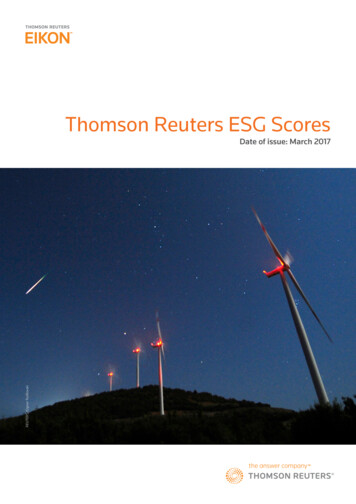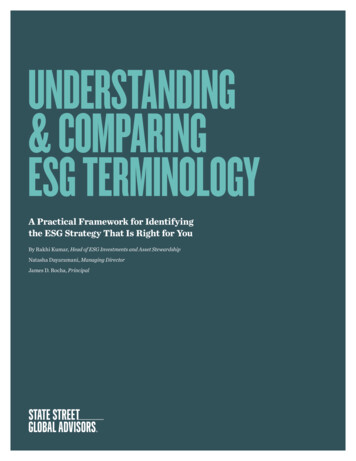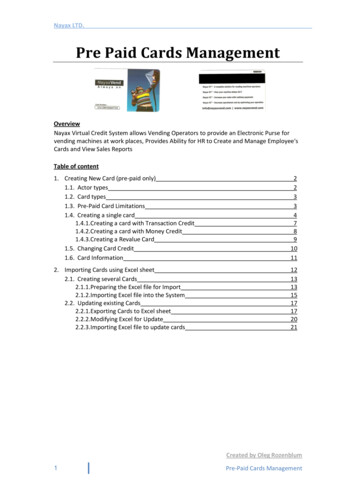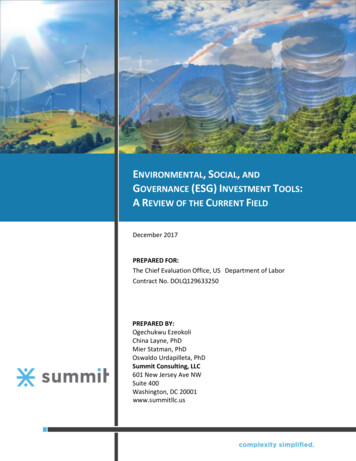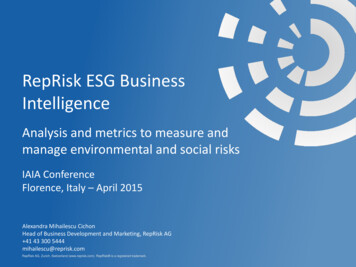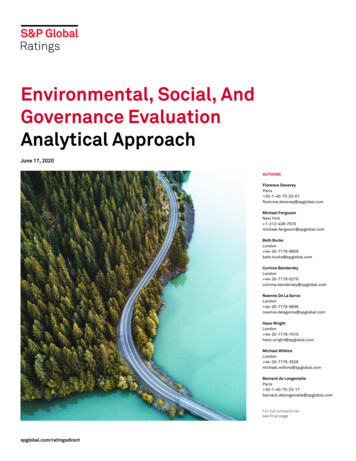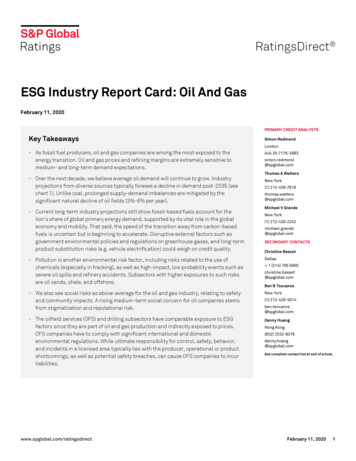
Transcription
ESG Industry Report Card: Oil And GasFebruary 11, 2020PRIMARY CREDIT ANALYSTSKey TakeawaysSimon RedmondLondon- As fossil fuel producers, oil and gas companies are among the most exposed to theenergy transition. Oil and gas prices and refining margins are extremely sensitive tomedium- and long-term demand expectations.- Over the next decade, we believe average oil demand will continue to grow. Industryprojections from diverse sources typically foresee a decline in demand post-2035 (seechart 1). Unlike coal, prolonged supply-demand imbalances are mitigated by thesignificant natural decline of oil fields (3%-6% per year).- Current long-term industry projections still show fossil-based fuels account for thelion's share of global primary energy demand, supported by its vital role in the globaleconomy and mobility. That said, the speed of the transition away from carbon-basedfuels is uncertain but is beginning to accelerate. Disruptive external factors such asgovernment environmental policies and regulations on greenhouse gases, and long-termproduct substitution risks (e.g. vehicle electrification) could weigh on credit quality.(44) 20-7176-3683simon.redmond@spglobal.comThomas A WattersNew York(1) 212-438-7818thomas.watters@spglobal.comMichael V GrandeNew York(1) 212-438-2242michael.grande@spglobal.comSECONDARY CONTACTSChristine Besset- Pollution is another environmental risk factor, including risks related to the use ofchemicals (especially in fracking), as well as high-impact, low probability events such assevere oil spills and refinery accidents. Subsectors with higher exposures to such risksare oil sands, shale, and offshore.Dallas- We also see social risks as above-average for the oil and gas industry, relating to safetyand community impacts. A rising medium-term social concern for oil companies stemsfrom stigmatization and reputational risk.New York- The oilfield services (OFS) and drilling subsectors have comparable exposure to ESGfactors since they are part of oil and gas production and indirectly exposed to prices.OFS companies have to comply with significant international and domesticenvironmental regulations. While ultimate responsibility for control, safety, behavior,and incidents in a licensed area typically lies with the producer, operational or productshortcomings, as well as potential safety breaches, can cause OFS companies to incurliabilities.Danny Huangwww.spglobal.com/ratingsdirect 1 (214) 765 5865christine.besset@spglobal.comBen B Tsocanos(1) 212-438-5014ben.tsocanos@spglobal.comHong Kong(852) 2532-8078danny.huang@spglobal.comSee complete contact list at end of article.February 11, 20201
ESG Industry Report Card: Oil And GasAnalytic ApproachEnvironmental, social, and governance (ESG) risks and opportunities can affect an entity'scapacity to meet its financial commitments in many ways. S&P Global Ratings incorporates theseconsiderations into its ratings methodology and analytics, which enables analysts to factor inshort-, medium-, and long-term impacts--both qualitative and quantitative--to multiple steps oftheir credit analysis. Strong ESG credentials do not necessarily indicate strong creditworthiness(see "The Role Of Environmental, Social, And Governance Credit Factors In Our Ratings Analysis,"published Sept. 12, 2019).Our ESG report cards qualitatively explore the relative exposures (average, below, above average)of sectors to environmental and social credit factors over the short, medium, and long term. Forenvironmental exposures, chart 1 shows a more granular listing of key sectors and (in some cases)subsectors reflecting the qualitative views of our analytical rating teams. This sector comparisonis not an input to our credit ratings and not a component of our credit rating methodologies; it isbased on our current qualitative, forward-looking opinion of credit risks across sectors.In addition to our sector views, this report card lists ESG insights for individual companies,including how and why ESG factors may have had a more positive or negative influence on anentity's credit quality compared to sector peers or the broader sector. These comparative views ofenvironmental and social risks are qualitative and established by analysts during industryportfolio discussions, with the goal of providing more insight and transparency.Environmental risks we considered include greenhouse gas (GHG) emissions, including carbondioxide, pollution, and waste, water and land usage, and natural conditions (physical climate,including extreme and changing weather conditions, though these tend to be moregeographic/entity-specific than a sector feature). Social risks include human capitalmanagement, safety management, community impacts, and consumer-related impacts fromcustomer service and changing behavior to the extent influenced by environmental, health, humanrights, and privacy (but excluding changes resulting from broader demographic, technological, orother disruptive industry trends). Our views on governance are directly embedded in our ratingmethodology as part of the management and governance assessment score.www.spglobal.com/ratingsdirectFebruary 11, 20202
ESG Industry Report Card: Oil And GasChart 1The list of entities covered in this report is not exhaustive. We may provide additional ESG insightsin individual company analyses throughout the year as they change or develop, with companiesexpected to increasingly focus on ESG in their communication and strategy updates.www.spglobal.com/ratingsdirectFebruary 11, 20203
ESG Industry Report Card: Oil And GasChart 2Exploration And ProductionEnvironmental exposureWe see environmental risks for the exploration and production (E&P) industry as well aboveaverage, stemming from two types of risks. The first stems from inherent material exposure togreenhouse gas emissions. The second type concerns lower probability but potentiallyhigh-impact risks for individual companies from pollution because of well head and transportspills and leaks, and increasingly water use and contamination risks. The most significant risk isthe pace of the energy transition away from carbon-based fuels; this could result in strongerdeviations from the industry demand forecasts outlined below. It will likely be strongly influencedby long-term government policies for renewable energy, as well as the pace of electric vehiclepenetration growth. Risk of secular change and substitution by products, services, andtechnologies is also a risk embedded in our key credit factors for oil and gas companies.The combustion of carbon-based fuels, specifically oil-derived products and natural gas, resultsin carbon dioxide. Natural gas, largely methane, is another greenhouse gas itself (when released)and has 25 or so times the impact of carbon dioxide. Production activities can also be a directsource of greenhouse gases, through methane leaks, gas flaring or extraction methods.Oil production (and prices) are more exposed over the longer term. According to many marketwww.spglobal.com/ratingsdirectFebruary 11, 20204
ESG Industry Report Card: Oil And Gasprojections, over the next two decades we will likely reach a point known as peak oil, in whichaggregate demand for oil will peak and then start to decline. However, demand will likely continueto increase significantly before then. This change would also affect demand for OFS, result instranded reserves, and likely weigh on prices, depending on the extent and timing of supplycorrections, including the typical onshore conventional oilfield decline rate of 3%-6% per year.These risks could also affect the sector by limiting funding availability. Funding constraints forbanks and other investors are more common for coal producers, but may well increasingly affectother fossil fuel producers and the sector as a whole.Also, the risk of pollution is material for companies producing and transporting hydrocarbons andmay result in material financial and reputational damage. While infrequent and unpredictable, theoccurrence of disasters with the magnitude of the Deepwater Horizon oil spill in the MacondoProspect can severely affect issuer credit quality due to the significant liabilities incurred fromenvironmental remediation, government fines, and lawsuits from affected industries andconsumers. Such liabilities totaled over 60 billion in the case of Macondo. Oil tanker spills, even ifvessels aren't operated by an oil company itself, can be a source of material litigation. Finally, theincreased frequency of extreme weather events (such as hurricanes) create greater operationalrisk.The environmental impact of plastic waste is another topic of consumer focus. Such plastics arelargely derived from petrochemicals, which altogether account for about 14% of crude oil demand.Nonetheless, depending on how plastics are used in construction, their carbon content iseffectively sequestered. Water use and the risk of contamination of land and aquifers isparticularly relevant for shale oil and gas producers as a result of hydraulic fracturing activities.Many countries have stringent development, operating, and decommissioning requirements andpotential penalties for companies that extract hydrocarbons. These regulations vary by countryand state; for example, Colorado has stricter requirements than other U.S. states. Moreover, manyE&P companies, such as those operating in the Gulf of Mexico and North Sea, incur significantasset retirement (decommissioning) obligations that we include as debt in our credit ratios.Although a fossil fuel, we consider natural gas to be somewhat less exposed to environmental risk.This is because, when burnt for power generation, gas is significantly less polluting than coal.Hence, gas may be seen as a vital bridge fuel in the energy transition to systemic decarbonization,notably in the U.S. given its ample shale reserves. This could support demand growth over the nexttwo decades. However, significant growth in gas would not be in line with a 2-degree Celsiusscenario, making the gas industry exposed to more renewables policies over time. Comparingbetween gas producers and value chains, we note the higher total emissions arising from theliquefaction and delivery of liquefied natural gas (LNG) versus piped gas.Social exposureWe see social risks in the oil and gas sector equally as above average based on its exposure tosafety management, social cohesion, and ultimately consumer behavior risks, which may lead tosubstitution of products. Per our key credit factors criteria, these factors that can influenceproducers' profitability, as well as substitution risks ultimately driven by consumer choices. Safetymanagement is a key risk given drilling activities and sometimes harsh environmental conditions,especially offshore. Companies in the sector typically track and manage incidents and havespecific programs to educate workforces. The costs to ensure adequate safety and compliancewith local regulations can be material, for example, in instances where crew time offshore islimited.Social cohesion is another key risk, specifically in terms of licenses to operate, given land use andwww.spglobal.com/ratingsdirectFebruary 11, 20205
ESG Industry Report Card: Oil And Gasdisruptions that drilling and production sites can typically create for local communities. Access tomarkets can also be contentious, as shown by the Trans Mountain and Keystone XL pipelines inNorth America. Relationships with communities and governments are important in that a lack ofshared benefits could create opposition. This can delay or raise costs for companies' reservedevelopments or even render them unviable, constraining growth and returns on capital. Ourcompetitive position assessments capture both these qualitative aspects in competitiveadvantage and quantitative measures such as cash and full-cycle costs in operating efficiency.Long-term consumer behavior will likely be increasingly influential in the energy transition awayfrom carbon fuels and in reduced use of disposable plastics or those that are uneconomical torecycle. Low-carbon transport is exemplified by the adoption of electric cars, though this won'tlikely affect oil demand in the next decade. Current long-term industry projections (see chart 1)still show fossil-based fuels account for the lion's share (75% of more) of global primary energydemand in 2035 (potentially 30% for oil, 25% for gas), but substitution risk is real and couldbecome more material in our view, depending on future federal policies and competition frombatteries and renewable energy. Ultimately, the sustainability of oil and gas companies' businessmodels depends on factors including the balance of supply and demand, and the all-in costs andfunding to continue producing and delivering oil and gas to users.GovernanceWhile governance is best measured at the company level, we believe the E&P sector hasabove-average exposure. This results from the strong compliance and oversight needed becauseof the sensitivities around bidding for and corruption relating to natural resources, particularly inemerging markets. Government ownership can exacerbate the sector's lack of transparency.Furthermore, the high severity of safety incidents also means board oversight and understandingof risk management and company culture have high importance.Refining And MarketingEnvironmental exposureWe consider environmental risks in the refining and marketing sector as well above averagebecause the refining process itself is an important source of carbon dioxide emissions andproduces carbon-based fuels and products, demand for which will be influenced by the energytransition. The sector has material exposure to regulations on greenhouse gas emissions andcarbon taxes, as well as to pollution, transport spills, and contamination risks. Exposure tophysical climate change and severe weather is particularly relevant for U.S. Gulf Coast refiners.The risk of pollution and accidents is significant for companies refining and distributinghydrocarbons and may result in material financial and reputational damage. The risk of landcontamination during operations and the cost of clean-up before property can be turned over foralternative use are also significant, especially at refineries. Therefore, asset retirementobligations that we include in adjusted debt can be material. Hydrocarbon fuels are flammableand frequently produced near and distributed through populated areas. Therefore, most countrieshave stringent operating and safety requirements for refiners and marketers of oil products. Thecosts of remaining compliant with these requirements can be material and may be onedifferentiator between companies' competitive positions and profitability in different countriesand regions.www.spglobal.com/ratingsdirectFebruary 11, 20206
ESG Industry Report Card: Oil And GasSocial exposureSocial risks in the refining and marketing sector are above average and weighted toward exposureto safety, social, and, ultimately, consumer behavior. Safety management is critical and generallyroutine given that oil products are combustible and pollutants. With the large scale of somerefinery complexes, accidents can be major events involving fatalities. Companies in the sectortypically track and manage incidents and have specific programs to educate workforces. Theseverity of incidents was demonstrated by the March 2005 catastrophic fire and explosions at BPPLC's America Refinery in Texas City during the restarting of a hydrocarbon isomerization unit.Fifteen workers were killed and 180 others were injured. At the PDVSA Amuay plant in August2012, an explosion killed 47 after a gas leak and operations were severely affected. We view otheraccidents, which are typically less severe, as weighing on refiners' operating efficiency: Refinerswith a history of accidents or poor safety records tend to have weaker business risk assessmentsthan peers.We believe consumer behavior will likely be increasingly influential in the energy transition awayfrom carbon fuels. Longer-term risk could stem from supply-demand imbalances, which could beprolonged and heavily weigh on refining margins. This is particularly important given refineries arelong-term fixed assets. In addition, environmental factors may directly influence shifts in productmix and volumes, as seen with the International Maritime Organisation's mandated reductions inthe sulphur content of bunker fuel, or IMO 2020. This involves some significant investmentrequirements for refineries in terms of upgrading or changing refinery set-ups, although it mayalso create opportunities to capture premium margins.As concerns about global warming grow, fuel retailers, as the local face of the oil industry, mightface more protests and disruptions. Poor management of social and particularly safety factorstypically leads to reputational issues, with differing impacts on companies and theircreditworthiness.OFS And DrillingFor decades, oil and gas producers have outsourced most of the activities associated with thelifecycle of oil or gas fields to OFS companies. We believe these companies, which provide drillingand construction and supply services, have similar above-average exposure to many of the sameenvironment and social risks and requirements as oil and gas producers. OFS revenues and profitmargins are generally strongly influenced by prevailing and expected supply and demandbalances and oil and gas prices. Ultimate responsibility for control, safety, behavior, and incidentsin a licensed area typically lies with the operator (the producer). However, operational or productshortcomings, as well as safety breaches, can create significant liabilities, such as for TransoceanLtd. after Macondo, and reputational damage. Strong safety cultures and safety records are acredit strength. Similarly, experienced crews on proven offshore rigs and drillships are oftenpreferred to cheaper, untested providers. Leading operators, such as the supermajors and manynational oil companies, will typically have stringent qualifying requirements, in part to managereputational risks. We can assess positively the competitive positions of those service or drillingcompanies that routinely meet these conditions.Finding, training, and retaining employees of a sufficient caliber at the right time can beproblematic. In this context, so-called local content requirements for fields and contracts in somecountries can have unintended consequences and present risks to performance, safety, andprofitability. For example, some of the recent problems in the Brazilian vessel supply and offshoreindustry can be attributed to local content requirements in the context of the rapid, hugewww.spglobal.com/ratingsdirectFebruary 11, 20207
ESG Industry Report Card: Oil And Gasdevelopments of pre-salt reserves. These challenges also highlighted risks relating toprocurement and tendering. Tendering can expose companies to significant risks, includingbribery, especially for high value contracts.www.spglobal.com/ratingsdirectFebruary 11, 20208
ESG Industry Report Card: Oil And GasESG Risks In Oil And GasEurope, Middle East, And Africa E&P And IntegratedTable 1Company/Rating/CommentsAnalystAker BP ASA (BBB-/Stable/--)Edouard OkasmaaWe view AKER BP as less favorably positioned than global peers in terms of environmental exposure, due to 100% pure play offshore oil andgas production on the Norwegian continental shelf. This leaves the company more vulnerable to the risks of spills, partly mitigated by theabsence of exposure to deep and ultra-deep water production, and the strict environmental regime in Norway. Furthermore, the risk appearswell managed, as it has avoided any material event in the past decade. In addition, AKER BP's carbon dioxide emissions rate per barrel is wellbelow the industry average, which over time could benefit it in the context of carbon dioxide taxation.BP PLC (A-/Positive/A-2)Simon RedmondWe believe BP is more exposed to environmental risks compared to the broader industry. The Macondo incident in the Gulf of Mexico, even if10 years ago, has demonstrated how big financial losses can be in the event of an oil spill. We believe this incident was a wake-up call for BPand the entire industry. While we believe that management has improved safety and current safety statistics are in line with peers, theconsequences of any material environmental incident for BP (notably in the U.S.) would still be worse than for its peers in our view. BP is one ofthe leaders in the global energy transition and is committed to reducing carbon emissions in line with the Paris Climate Agreement. BP'sportfolio enjoys a higher share of natural gas than most of the other majors. BP is also investing in renewables, similar to its peers, but so farthese investments have not exceeded 5% of total capital spending.Eni SpA (A-/Stable/A-2)Edouard OkasmaaWe view ENI's exposure to environmental risks as similar to the broader oil and gas industry, even if it aims to increase its share of natural gasproduction to 60% and management is committed to have a net zero carbon footprint for direct emissions of equity upstream activities by2030 (scope 1), also offsetting through forestry projects. In coherence with this, by 2025 Eni aims to eliminate gas process flaring and reducefugitive methane emissions by 80% versus 2014. Downstream, the company has transformed two of its loss-making refineries into biofuelrefineries, improving profitability and the company's impact on the environment. Eni remains engaged in clean-up and restitution initiatives inrelation to chemical plants and other activities in Italy and elsewhere. The company's decarbonization strategy includes 3 billion (9% ofgroup 2019-2022 capex), with 950 million allocated for circular economy projects and 1.4 billion for renewable projects, for a total installedcapacity of 1.6 gigawatts by 2022. We assess Eni's management and governance as satisfactory. A key area of risk for Eni, with largeoperations in Africa, relates to strong policies and oversight on bribery and other illegal activities. Eni provides extensive details on itsAnti-Corruption Compliance Programme and was the first Italian company to receive the ISO 37001:2016 "Anti-Bribery Systems" certification.Recently allegations were made by the Nigerian government that bribes were made by or on behalf of Eni. While the company denies any illegalactivity, this highlights the risk of operating in certain countries. Overall, we take into account Eni's longstanding operations in Africa, andformer legal cases, for example in Algeria, where Eni was acquitted.EnQuest PLC (B-/Positive/--)Ivan TiutiunnikovWe see environmental risk for Enquest as relatively higher than peers in the E&P sector given its mainly oil operations in the offshore NorthSea, concentrated in the Kraken and Magnus fields, which accounted for more than half of production in the first half of 2019. In our view,production activities in that area bear high operational risk, which, if an oil spill occurred, would result in high environmental and reputationaldamage. The key mitigating factor stems from the company's good track record, with improving incident rates that are in line with its peers inthe sector.Equinor ASA (AA-/Stable/A-1 )AlexanderGriaznovWe think Equinor is more exposed to environmental risks because of its higher share of offshore operations, which would be more severelyaffected by a low-probability spill. However, Equinor's track record in offshore is very robust since it has avoided any major oil spills over thepast 10 years. Equinor's injury frequency is slightly higher than peers', which also reflects a higher share of offshore operations, where theinjury rate is naturally higher because the process is more technically challenging. Otherwise, Equinor is one of the leading companies globallyin the energy transition. Equinor accepted multiple initiatives under its climate roadmap to reduce its environmental footprint by turning to alow-carbon oil and gas portfolio and building a strong position in renewables. Equinor aims to reduce annual carbon dioxide emissions by 3million tons by 2030. One of the ways to achieve this is by eliminating flaring in its operations to zero by 2030. The company's decarbonizationstrategy also includes significant investments in new energy, constituting around 15%-20% of annual capital expenditures (capex) by 2030.Equinor has already built a notable presence in wind energy and is continuing to do so with its Empire Wind and Dogger Bank projects.Equinor US Holdings Inc. (A/Stable/A-1)www.spglobal.com/ratingsdirectIvan TiutiunnikovFebruary 11, 20209
ESG Industry Report Card: Oil And GasEquinor US Holdings is more exposed to environmental risks than its peers, primarily due to its offshore operations in the Gulf of Mexico,which have higher sensitivity to environmental damage in case of oil spills (including significant cleanup costs and legal obligations). Thatsaid, Equinor US has policies and procedures to minimize such risks. In addition, similar to its parent, the company is looking at ways todiversify its operations into renewables, in particular wind energy in the U.S. (although material contributions may only be visible in the longterm).Gazprom PJSC (BBB/Stable/A-2)Elena AnankinaGazprom's exposure to environmental and social factors is comparable to that of broader oil and gas industry. With 90% of Gazprom'sproduction being gas, Gazprom ranks below most oil majors on carbon emissions, and has publicly communicated targets to reducegreenhouse gas emissions. At the same time, methane leaks have a powerful greenhouse gas effect. EU policies aimed at increasing the shareof intermittent renewable generation could negatively affect Gazprom's pipeline exports to Europe, most likely over the long term. In our view,how long gas will remain a bridge fuel to the low-carbon future will depend on the development of new energy storage technologies and EUmandates. On the other hand, China's focus on transitioning from coal to cleaner gas fuel creates future export opportunities for Gazprom,subject to multibillion dollar investments. Social considerations are both positive and negative credit factors for Gazprom. Gazprom's socialmandates in Russia weigh negatively on our business risk assessment, given strongly subsidized local gas pricing and reduced flexibility tocurb spending. However, they also create incentives for the Russian government to protect and support the company and factor in positivelywhen assessing its role and link with the Russian government.Ithaca Energy Ltd. (B /Stable/--)Ivan TiutiunnikovWe view Ithaca's environmental risk exposure as higher than peers in the industry, reflecting its concentrated exposure to two main operatingfields in the North Sea after acquiring assets from Chevron. This poses a risk of low probability, high-impact events related to oil spills andcontamination, especially because we consider operations in the North Sea being high risk. We reflect this in our weak business risk profileassessment, though the company has no history of material environmental issues. The company also has a robust health and safety trackrecord, with low and declining injury rates over the past few years. We understand that its previous owner, Chevron, did not experiencematerial health and safety issues at the North Sea assets in the past.Neptune Energy Group Midco Ltd. (BB-/Positive/--)Ivan TiutiunnikovWe view Neptune as having higher environmental exposure than peers, reflecting its high share of offshore production, notably in the NorthSea, where regulation is more stringent and risks related to harsh weather conditions are also important. This leaves the company morevulnerable to potential spills and other events that could materially impact its financial performance. This risk appears well managed by thecompany, which has avoided any material events in the past and has a well-below-industry-average carbon dioxide emissions rate per barrel.Repsol S.A. (BBB/Positive/A-2)ChristopheBoulierWe believe Repsol's exposure to ESG risks is overall comparable to its global peers, even though it is ahead of many industry players inintegrating energy transition in its strategy and has a higher share of upstream gas production (about 63%). In relative terms the company hasallocated more of its capital spending in 2018-2020 (including acquisitions) to renewables and low-carbon businesses (renewables andlow-carbon electricity generation, wholesale gas, and retail gas and power) than peers. Repsol is committed to achieve 7.5 GW of low-carbonelectricity generation capacity by 2025. Repsol's safety record has improved since 2013 (its total recordable incident rate has decreased to1.59 from 2.95 since then), but despite being satisfactory compared to the overall industry, it remains higher than close peers such as TotalS.A. or Royal Dutch Shell.Rosneft Oil Co. PJSC (BBB-/Stable/--)Simon RedmondWe view Rosneft's exposure to environmental and social risks as similar to the broader oil and gas industry. While the incidence of oil spills inits Russian operations has been high, the fines have been financially modest and we believe that Rosneft's status as a national oil companylimits its potential exposure. Also, in 2018, the number of reported incidents dropped by 45%, representing a 9% reduction in terms of theamount of oil spilt. The company's refineries are being upgraded, but many still produce EURO-5 standard fuels, which have higher emissionsof particulates and nitrogen oxides. It was the first in Russia to produce and sell EURO-6 gasoline, which is currently marketed in Moscow and578 stations elsewhere. We assess Rosneft's management and governance as satisfactory. Rosneft is a public joint-stock company, with arelatively autonomous management team, and most board members represent not only the Russian government, but also BP. Nonetheles
ESG Industry Report Card: Oil And Gas February 11, 2020 Key Takeaways - As fossil fuel producers, oil and gas companies are among the most exposed to the energy transition. Oil and gas prices and refining margins are extremely sensitive to medium- and long-term demand expectations. - Over the next decade, we believe average oil demand will continue to grow. Industry projections from diverse .

